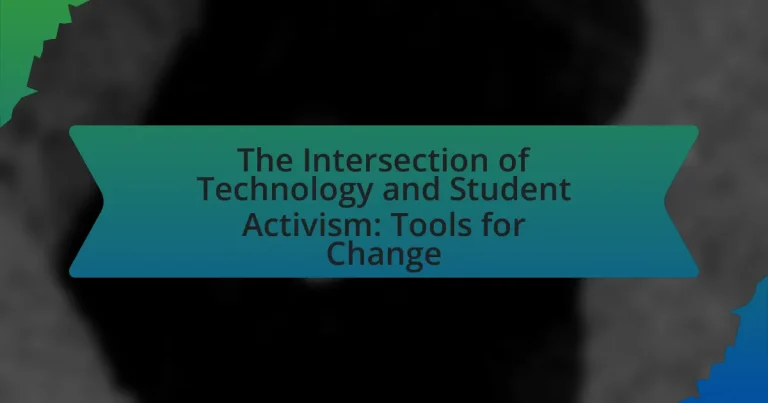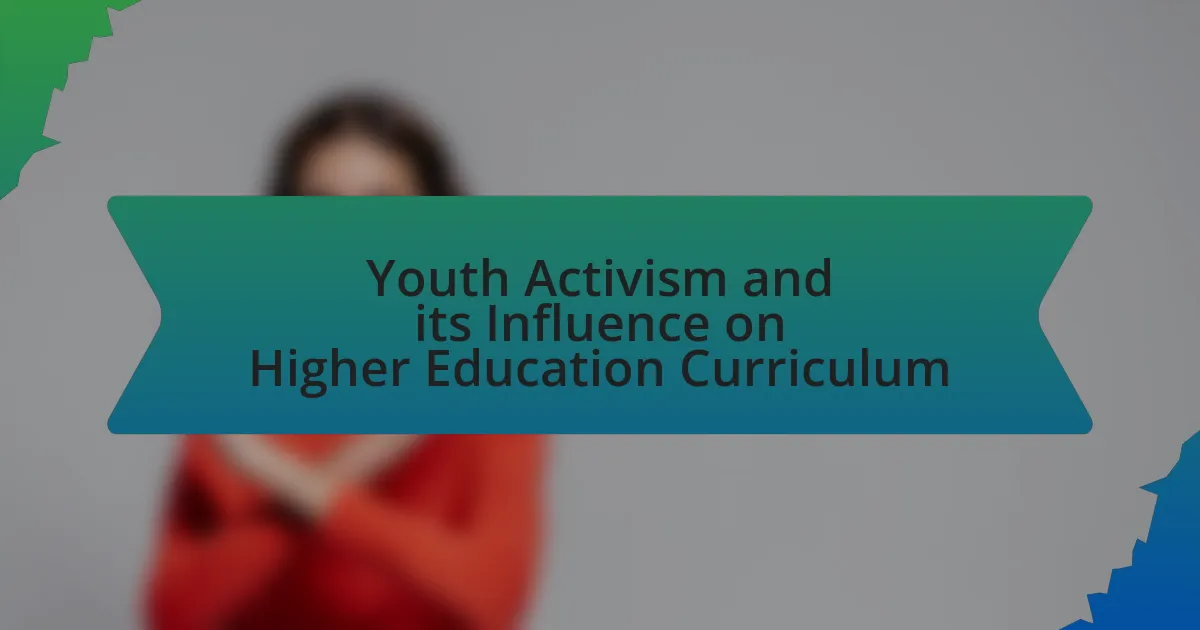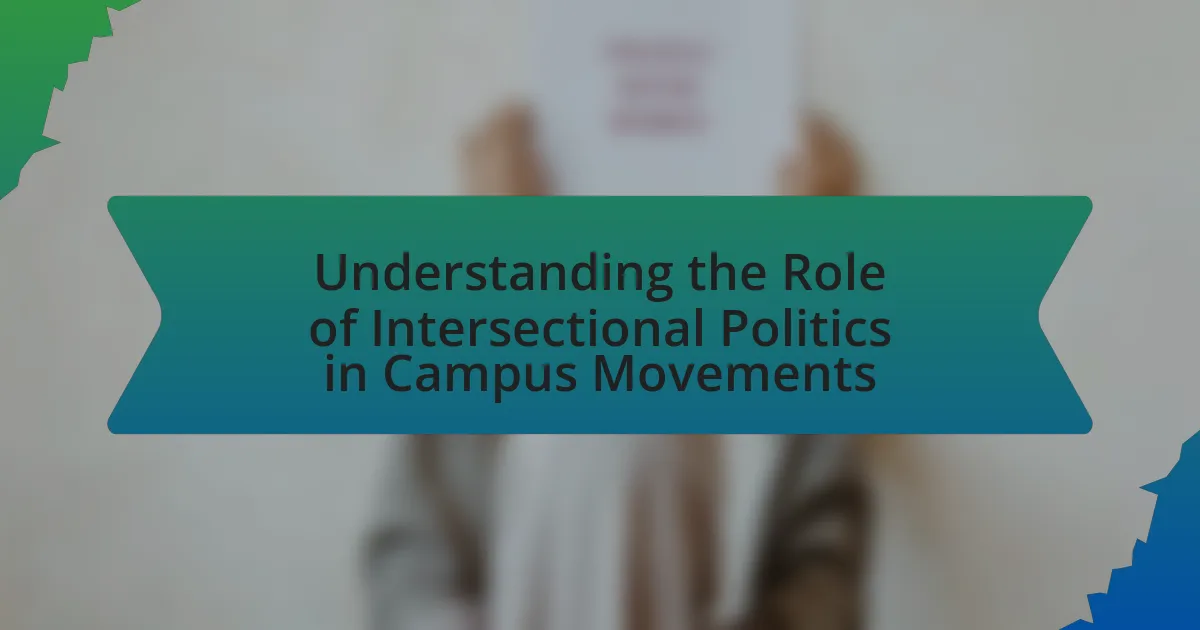The article examines the intersection of technology and student activism, highlighting how digital tools and platforms empower students to organize, mobilize, and amplify their voices in social and political movements. It discusses the significant influence of social media, mobile applications, and online petitions in enhancing communication and awareness among young activists. Key technological tools and strategies for effective activism are outlined, along with the challenges posed by misinformation and surveillance. The article also explores future trends in technology and their potential impact on student movements, emphasizing the importance of leveraging data analytics and emerging technologies for advocacy.
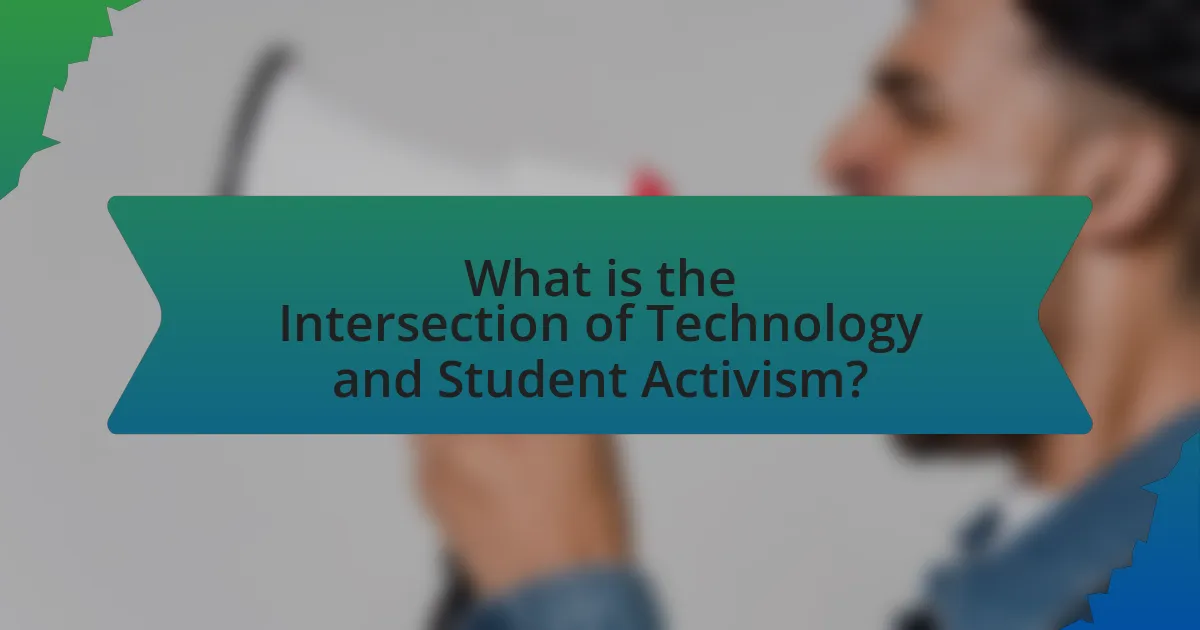
What is the Intersection of Technology and Student Activism?
The intersection of technology and student activism is characterized by the use of digital tools and platforms to organize, mobilize, and amplify student voices in social and political movements. Technology enables students to communicate rapidly, share information widely, and coordinate actions across geographical boundaries, enhancing the effectiveness of their activism. For instance, social media platforms like Twitter and Instagram have been pivotal in movements such as Black Lives Matter and climate strikes, allowing students to raise awareness and engage with a global audience. Research indicates that 79% of young activists believe social media is essential for their efforts, demonstrating its critical role in modern activism.
How has technology influenced student activism in recent years?
Technology has significantly influenced student activism in recent years by enhancing communication, mobilization, and awareness. Social media platforms like Twitter and Instagram have allowed students to organize protests, share information rapidly, and amplify their voices on issues such as climate change and racial justice. For instance, the #FridaysForFuture movement, initiated by Greta Thunberg, gained global traction through social media, mobilizing millions of students worldwide to advocate for climate action. Additionally, online petitions and crowdfunding platforms have enabled students to gather support and resources for their causes more efficiently. According to a 2021 study by the Pew Research Center, 70% of young activists reported that social media was crucial in their efforts to raise awareness and engage others in activism. This demonstrates that technology has become an essential tool for student activists, facilitating greater participation and impact in social movements.
What are the key technological tools used by student activists?
Key technological tools used by student activists include social media platforms, mobile applications, and online petition systems. Social media platforms like Twitter and Instagram facilitate rapid information dissemination and community building, enabling activists to mobilize support and raise awareness. Mobile applications such as Signal and WhatsApp provide secure communication channels for organizing and strategizing without surveillance. Online petition systems like Change.org allow students to gather signatures and demonstrate public support for their causes, amplifying their impact. These tools have been instrumental in various movements, such as the 2019 climate strikes, where students utilized social media to coordinate global participation.
How do social media platforms facilitate student activism?
Social media platforms facilitate student activism by providing a space for rapid communication, organization, and mobilization of collective action. These platforms enable students to share information, raise awareness about social issues, and coordinate events or protests efficiently. For instance, during the 2018 March for Our Lives movement, students utilized Twitter and Instagram to organize rallies and disseminate information about gun control, reaching millions of users and garnering significant media attention. This demonstrates how social media not only amplifies student voices but also connects them with broader networks of support, enhancing the impact of their activism.
Why is the intersection of technology and student activism important?
The intersection of technology and student activism is important because it enhances the ability of students to organize, mobilize, and amplify their voices on social issues. Technology provides platforms for communication, such as social media, which enables rapid dissemination of information and fosters community engagement. For instance, the use of Twitter during the 2011 Arab Spring allowed activists to coordinate protests and share real-time updates, demonstrating how digital tools can facilitate grassroots movements. Additionally, research from the Pew Research Center indicates that 88% of young adults use social media, highlighting its role as a critical tool for activism among students. This synergy between technology and activism not only empowers students but also increases the visibility and impact of their causes.
What impact does technology have on the effectiveness of student movements?
Technology significantly enhances the effectiveness of student movements by facilitating communication, organization, and mobilization. Digital platforms enable students to quickly disseminate information, coordinate events, and rally support, which has been evidenced by movements such as the Arab Spring and the March for Our Lives. For instance, social media platforms like Twitter and Facebook have been pivotal in organizing protests and spreading awareness, allowing for real-time updates and engagement with a broader audience. Research from the Pew Research Center indicates that 88% of young adults use social media, underscoring its role as a vital tool for activism. Thus, technology not only amplifies student voices but also increases the reach and impact of their movements.
How does technology empower marginalized voices in activism?
Technology empowers marginalized voices in activism by providing platforms for communication, organization, and visibility. Social media, for instance, allows individuals from underrepresented communities to share their stories and mobilize support on a global scale, bypassing traditional media gatekeepers. According to a 2020 study by the Pew Research Center, 69% of adults in the U.S. use social media, which has become a crucial tool for grassroots movements like Black Lives Matter and #MeToo, enabling these groups to amplify their messages and reach wider audiences. Additionally, technology facilitates access to information and resources, empowering activists to educate themselves and others about social issues, thereby fostering a more informed and engaged community.
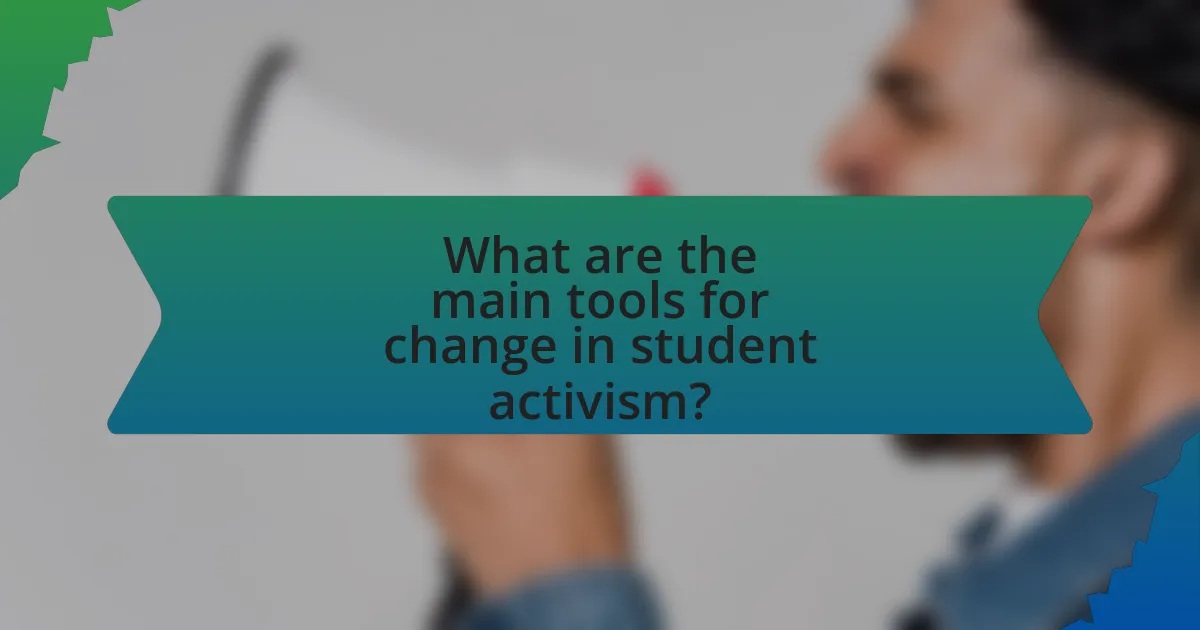
What are the main tools for change in student activism?
The main tools for change in student activism include social media platforms, grassroots organizing, and digital petitions. Social media platforms like Twitter and Instagram enable students to rapidly disseminate information, mobilize supporters, and raise awareness about issues, as evidenced by movements such as #BlackLivesMatter, which gained traction through online engagement. Grassroots organizing allows students to build local coalitions and create community-based initiatives, exemplified by the March for Our Lives movement, which was driven by student-led efforts to advocate for gun control. Digital petitions, such as those hosted on Change.org, provide a means for students to gather support and demonstrate public backing for specific causes, leading to tangible policy changes. These tools collectively empower students to effect change and influence decision-makers effectively.
How do digital communication tools enhance student organizing?
Digital communication tools enhance student organizing by facilitating real-time collaboration and information sharing among students. These tools, such as social media platforms, messaging apps, and collaborative software, allow students to quickly disseminate information, mobilize support, and coordinate events. For instance, a study by the Pew Research Center found that 88% of young adults use social media, which serves as a powerful medium for organizing protests and campaigns, enabling students to reach a wider audience efficiently. Additionally, platforms like Slack and Discord provide spaces for ongoing discussions and planning, fostering a sense of community and engagement among student activists.
What role do messaging apps play in coordinating protests?
Messaging apps play a crucial role in coordinating protests by facilitating real-time communication among activists. These platforms enable users to share information quickly, organize logistics, and mobilize participants effectively. For instance, during the Arab Spring, messaging apps like WhatsApp and Telegram were instrumental in organizing protests, allowing activists to bypass traditional media and communicate securely. Research indicates that 70% of young activists prefer using messaging apps for organizing events, highlighting their significance in modern activism.
How do online petitions mobilize support for student causes?
Online petitions mobilize support for student causes by providing a platform for collective action and amplifying voices that may otherwise go unheard. These petitions enable students to easily gather signatures and demonstrate widespread support for their initiatives, which can attract media attention and influence decision-makers. For instance, a study by the Pew Research Center found that 70% of young adults believe online activism is an effective way to create change, highlighting the perceived impact of digital tools in mobilizing support. Additionally, platforms like Change.org have facilitated millions of petitions, showcasing the power of online engagement in rallying community support for various student-led issues.
What are the challenges of using technology in student activism?
The challenges of using technology in student activism include issues of digital divide, misinformation, and surveillance. The digital divide creates barriers for students without access to reliable internet or devices, limiting their participation in online activism. Misinformation can spread rapidly through social media platforms, undermining the credibility of movements and causing confusion among supporters. Additionally, surveillance by authorities can deter students from engaging in activism, as their online activities may be monitored, leading to potential repercussions. These challenges highlight the complexities of leveraging technology effectively in student-led movements.
How can misinformation affect student-led movements?
Misinformation can significantly undermine student-led movements by distorting public perception and eroding trust among participants. When false information circulates, it can lead to confusion about the movement’s goals, strategies, and legitimacy, ultimately causing fragmentation within the group. For instance, during the 2018 March for Our Lives, misinformation about the event’s funding and organization spread on social media, which created skepticism among potential supporters and detracted from the movement’s message advocating for gun control. This illustrates how misinformation can divert attention from critical issues and weaken collective action, as students may become hesitant to engage or support a cause perceived as compromised by false narratives.
What are the risks of surveillance and privacy concerns for activists?
Surveillance poses significant risks to activists, primarily by compromising their privacy and safety. Activists often face monitoring from government agencies and private entities, which can lead to harassment, arrest, or violence. For instance, the use of facial recognition technology has been documented in protests, enabling authorities to identify and target individuals involved in activism. Additionally, data breaches can expose sensitive communications and personal information, further endangering activists and their networks. The chilling effect of surveillance can deter individuals from participating in activism, as fear of repercussions may inhibit free expression and assembly.
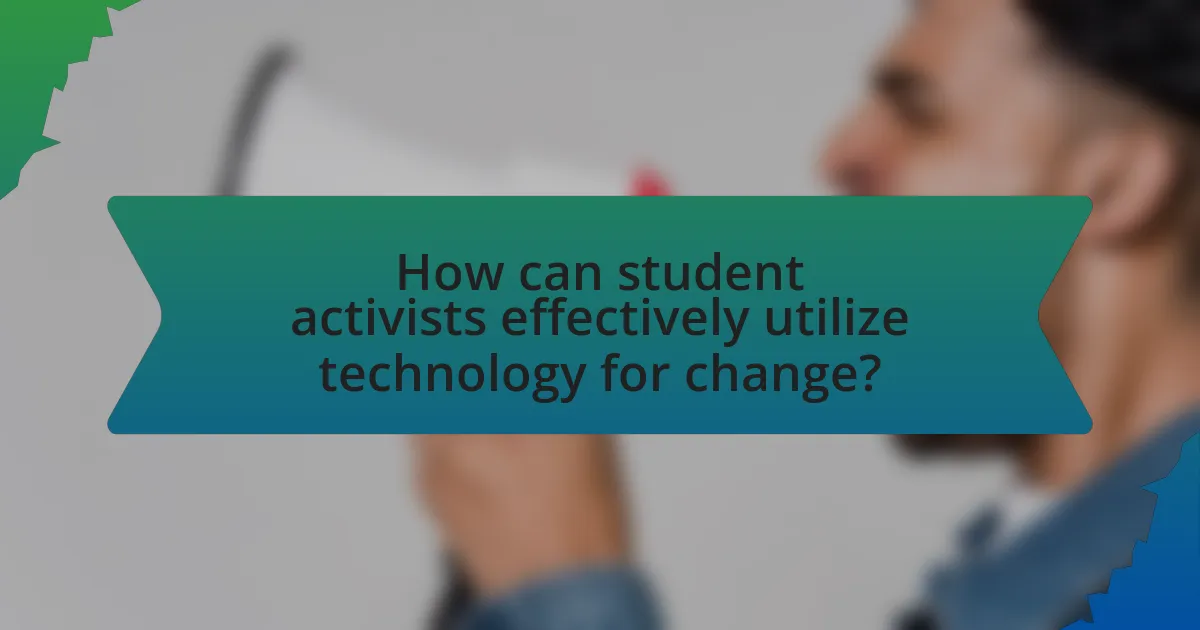
How can student activists effectively utilize technology for change?
Student activists can effectively utilize technology for change by leveraging social media platforms, online petitions, and digital communication tools to organize, mobilize, and raise awareness. Social media enables activists to reach a broad audience quickly; for instance, movements like #BlackLivesMatter gained momentum through Twitter and Instagram, showcasing the power of these platforms in amplifying voices and messages. Online petitions, such as those hosted on Change.org, allow activists to gather support and demonstrate public backing for their causes, often leading to tangible outcomes, as seen in various environmental campaigns. Additionally, digital communication tools like Zoom and Slack facilitate collaboration and planning among activists, enabling them to coordinate efforts efficiently, especially during times when in-person gatherings are challenging. These methods illustrate how technology serves as a critical enabler for student activists seeking to effect change.
What strategies can enhance the impact of technology in activism?
Utilizing social media platforms effectively can significantly enhance the impact of technology in activism. By leveraging platforms like Twitter, Facebook, and Instagram, activists can rapidly disseminate information, mobilize supporters, and create viral campaigns that raise awareness on critical issues. For instance, the #BlackLivesMatter movement gained global traction through strategic social media use, leading to widespread protests and policy discussions. Additionally, employing data analytics tools allows activists to track engagement and optimize their outreach strategies, ensuring that messages resonate with target audiences. This combination of effective communication and data-driven decision-making strengthens the overall impact of technological tools in activism.
How can students leverage data analytics for advocacy?
Students can leverage data analytics for advocacy by analyzing trends and patterns in social issues to inform their campaigns. By utilizing tools such as surveys, social media analytics, and public data sets, students can gather quantitative evidence that supports their causes. For instance, a study by the Pew Research Center found that 69% of Americans believe that data can help improve public policy, demonstrating the effectiveness of data-driven advocacy. This analytical approach allows students to present compelling arguments, identify key stakeholders, and measure the impact of their advocacy efforts, ultimately enhancing their ability to drive change.
What best practices should student activists follow when using social media?
Student activists should prioritize authenticity, clarity, and engagement when using social media. Authenticity fosters trust and credibility, as followers are more likely to support genuine voices. Clarity ensures that messages are easily understood, which is crucial for mobilizing support and conveying important information. Engagement involves interacting with followers, responding to comments, and encouraging discussions, which can amplify their message and build a community around their cause. Research indicates that campaigns with high engagement rates are more successful in reaching their goals, as seen in the #BlackLivesMatter movement, which effectively utilized social media to raise awareness and mobilize action.
What resources are available for student activists to learn about technology?
Student activists can access various resources to learn about technology, including online courses, workshops, and community organizations. Platforms like Coursera and edX offer courses on digital literacy, coding, and data analysis, which are essential skills for activism. Additionally, organizations such as Code for America and the Electronic Frontier Foundation provide workshops and resources focused on using technology for social change. These resources equip student activists with the necessary skills to effectively leverage technology in their advocacy efforts.
Where can students find training on digital activism tools?
Students can find training on digital activism tools through various online platforms and organizations dedicated to social change. For instance, organizations like the Digital Activism Research Project offer resources and workshops specifically designed for activists. Additionally, platforms such as Coursera and edX provide courses on digital tools for activism, often created by universities and experts in the field. These resources are validated by their partnerships with educational institutions and their focus on equipping students with practical skills for effective activism.
What organizations support technology education for activists?
Organizations that support technology education for activists include the Electronic Frontier Foundation (EFF), which provides resources and training on digital rights and privacy; TechSoup, which offers technology resources and support for nonprofits; and the Tactical Technology Collective, which focuses on empowering activists through technology training and tools. These organizations contribute to enhancing the skills and knowledge of activists, enabling them to effectively utilize technology in their advocacy efforts.
What are the future trends in technology and student activism?
Future trends in technology and student activism include the increased use of social media platforms for organizing and mobilizing, the integration of artificial intelligence for data analysis and strategy development, and the rise of decentralized technologies like blockchain for secure and transparent fundraising. Social media has proven effective in amplifying student voices, as seen in movements like #NeverAgain and #FridaysForFuture, where platforms facilitated rapid information dissemination and community building. Artificial intelligence tools are being utilized to analyze public sentiment and optimize campaign strategies, enhancing the effectiveness of activism efforts. Additionally, blockchain technology is emerging as a means to ensure transparency in donations and resource allocation, fostering trust among supporters. These trends indicate a shift towards more sophisticated, data-driven approaches in student activism, enabling more impactful and organized movements.
How might emerging technologies shape the landscape of activism?
Emerging technologies significantly shape the landscape of activism by enhancing communication, mobilization, and awareness. For instance, social media platforms like Twitter and Facebook allow activists to reach a global audience instantly, facilitating rapid information dissemination and community building. According to a study by the Pew Research Center, 69% of adults in the U.S. use social media, which has become a crucial tool for organizing protests and campaigns. Additionally, technologies such as blockchain can ensure transparency in fundraising and resource allocation, thereby increasing trust among supporters. The use of data analytics enables activists to target specific demographics effectively, optimizing outreach efforts. Overall, these technologies empower activists by providing innovative tools to amplify their voices and drive social change.
What role will artificial intelligence play in future student movements?
Artificial intelligence will play a crucial role in future student movements by enhancing organization, communication, and data analysis. AI tools can facilitate real-time communication among students, enabling rapid mobilization for causes. For instance, platforms utilizing AI algorithms can analyze social media trends to identify pressing issues and optimize outreach strategies, as seen in movements like Black Lives Matter, where data-driven insights significantly influenced engagement. Additionally, AI can help in monitoring sentiment and public opinion, allowing student activists to adapt their strategies effectively. This integration of AI into student activism not only streamlines efforts but also amplifies the impact of movements by leveraging technology for greater reach and efficiency.
What practical tips can student activists implement today?
Student activists can implement practical tips today by utilizing social media platforms to organize events and raise awareness. For instance, platforms like Twitter and Instagram allow activists to reach a wider audience quickly, facilitating the mobilization of supporters for causes. Research indicates that social media campaigns can increase engagement and participation in activism, as seen in movements like #BlackLivesMatter, which gained significant traction through online platforms. Additionally, student activists should leverage online petition tools, such as Change.org, to gather signatures and demonstrate public support for their initiatives, effectively influencing decision-makers.
